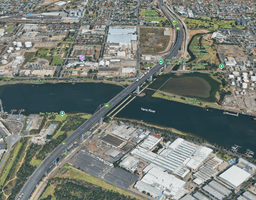“Lifting Through Complexity: Lessons from the West Gate Tunnel Project”
From Noise Walls to Bridges—How Smart Lifting Navigates High-Stakes Infrastructure
In a project the size and scale of Melbourne’s West Gate Tunnel, no two lifts are the same—and every single one is under the microscope. With over 14 kilometres of new road infrastructure, major interchanges, and a live freeway corridor, the lifting operations ranged from simple panel placement to complex multi-crane assemblies, all within a tightly governed Tier 1 compliance ecosystem.
From modular culvert lifts in tight corridors to noise wall panels hovering above live traffic, and bridge beams spanning water tables or rail corridors, this project tested the full spectrum of lifting capability—not just in machinery, but in planning, process, and paperwork.
Scope of Lifts on West Gate Tunnel
Noise Wall Panels: Precast vertical elements up to 15m long
Bridge Beams: Dual- and triple-crane heavy beam lifts over live roads and water
Culverts & Drainage Modules: Box units in narrow rail corridors with minimal clearance
Steel Gantries & Signage: Long-span assemblies lifted under night closures
Barrier Walls & Precast Deck Units: Repetitive but tolerance-critical lifts along viaducts
Key Lessons from the West Gate Tunnel Lift Program
1. Every Lift Is a Documented Risk in a Tier 1 Project
On a Tier 1 job, a lift isn’t just a task—it’s a regulated activity tied to engineering signoffs, daily permits, Safe Work Method Statements (SWMS), and multi-layered stakeholder approvals.
Lesson: Compliance must be pre-baked into your lift planning—not treated as an afterthought. We standardized our lift studies and pre-checks to speed up approvals without cutting corners.
2. Live Traffic and Public Interface Amplify Risk Exposure
Many lifts were done beside or over live roads, requiring temporary traffic management, spotters, and rapid lift execution within strict closure windows.
Lesson: We developed clock-tight lift sequences, often rehearsing movements with dry runs and using GPS-based rigging drop points to reduce set-down time.
3. Noise Wall Lifts Demand Vertical Precision in Wind-Exposed Corridors
While they may appear simple, noise wall panels are tall, narrow, and act like sails in wind.
Lesson: Wind compliance (AS 2550), taglines, and dual-tether bracing were non-negotiable. We worked under strict wind limits and used rotating rigging to align panels mid-air.
4. Rail & Utility Corridors Have Zero Tolerance for Error
Culvert and box drain lifts near live rail and utility corridors had limited swing space, often requiring night work or “possession windows.”
Lesson: We used ultra-short rigging and low-profile spreaders, with line-of-sight spotters to guide lifts through gaps as small as 200mm. Pre-lift simulations were critical.
5. Bridge Lifts Were Not About Strength—They Were About Systems
The biggest challenge wasn’t always lifting the beams—it was ensuring every approval, permit, engineering calculation, and hold point was cleared in time.
Lesson: We integrated with head contractor systems (like Aconex or TeamBinder) and mapped our lift schedule to the project’s commissioning milestones to avoid delays.
6. Lifting at This Scale Requires Proactive Engineering Leadership
A project like West Gate Tunnel has audits, random site inspections, design reviews, and Principal Contractor scrutiny daily.
Lesson: We took a “no surprises” approach—bringing forward risks, offering alternatives, and providing PE-stamped lift studies that showed foresight, not just compliance.
Conclusion: Compliance Is the Minimum—Leadership Is the Advantage
The West Gate Tunnel Project wasn’t just about big machines—it was about lifting with foresight in one of Australia’s most heavily governed construction environments.
From noise walls to culverts to bridges, every lift was a test of planning, not just capacity. In projects like these, what sets you apart isn’t whether you lift—it’s how you lift through layers of complexity, bureaucracy, and precision.
If your next infrastructure job demands Tier 1 compliance, stakeholder coordination, and engineered lift certainty—talk to a team who’s done it, live, on Melbourne’s biggest roads.

